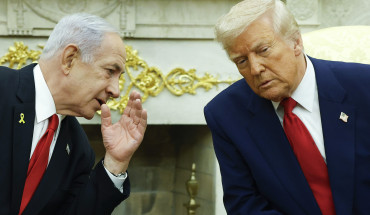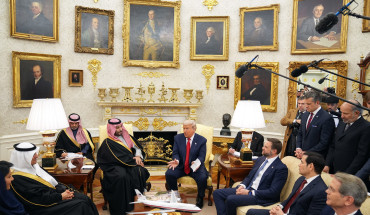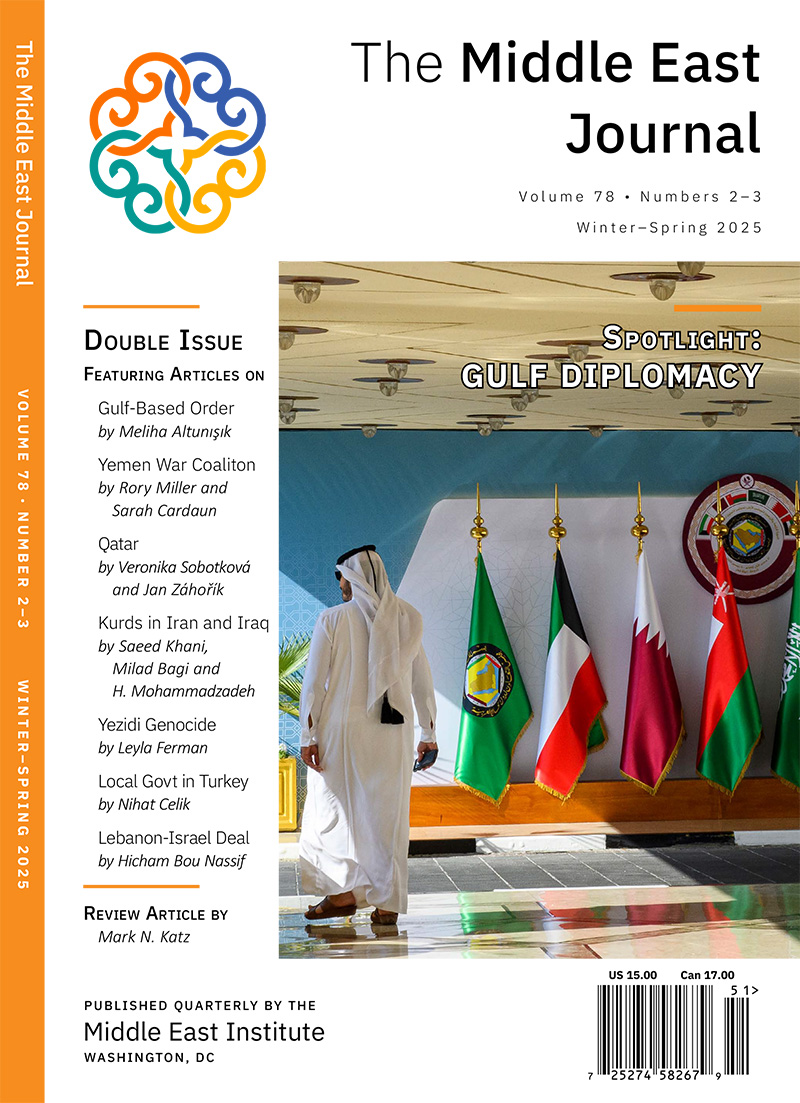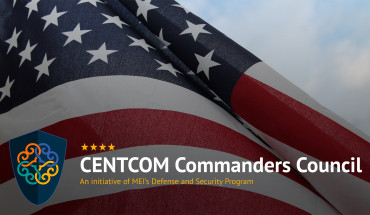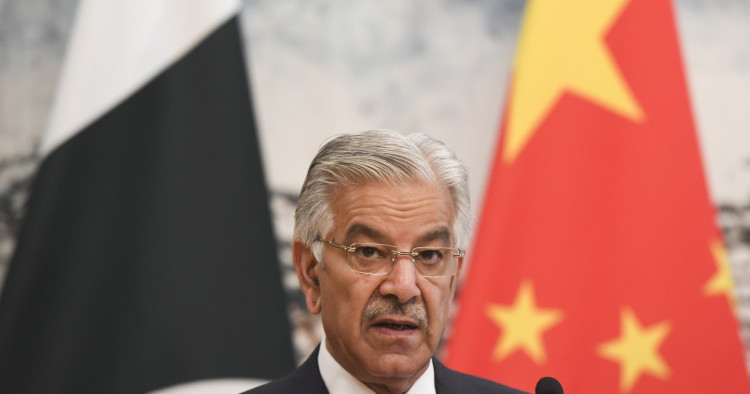The Saudi-Pakistan Strategic Mutual Defense Agreement, signed on September 17, 2025, is a significant regional development. MEI has published several articles that provide different perspectives on the defense pact. For other analysis, please see F. Gregory Gause’s “Don't believe the hype: The modest reality of the Saudi-Pakistani defense pact” and Naade Ali and Marvin Weinbaum’s “Pakistan’s strategic defense pact with Saudi Arabia: A new security architecture in the wider Middle East.”
The Strategic Mutual Defense Agreement (SMDA) between Saudi Arabia and Pakistan, signed in Riyadh on September 17, is far more than a bilateral pledge. It represents a profound reordering of alignments in the Gulf and South Asia, reflecting and reinforcing the broader erosion of US preeminence in the Eurasian security architecture.
While much of the initial commentary centered on the striking commitment of a wealthy Gulf monarchy to the defense of a nuclear-armed South Asian state, as well as the question of whether Pakistan had in fact extended its nuclear umbrella to Saudi Arabia, the deeper story is arguably China’s potential advance. Without fanfare or direct involvement in the pact, Beijing could potentially benefit over the long term, positioned to consolidate influence in defense cooperation, nuclear energy, strategic maritime corridors, and even regional mediation.
The convergence of Saudi and Pakistani strategies
Saudi-Pakistani defense relations have been intimate since the 1970s, when Pakistani officers first deployed to the Gulf to train Saudi armed forces, strengthen internal security, and develop air defense frameworks. Pakistani pilots flew Saudi aircraft in the 1969 al-Wadiah conflict against South Yemen, and Riyadh’s generous financial support sustained Islamabad’s defense-industrial structures during decades of turbulence. Bilateral defense and security ties remain robust today. Approximately 1,600 Pakistani personnel currently assist Saudi Arabia in air defense, officer training, and security cooperation, extending a decades-long tradition of Pakistani involvement in the kingdom’s armed forces. From Saudi Arabia’s perspective, Pakistan offers manpower and experience; from Pakistan’s vantage point, Saudi Arabia offers an economic lifeline and political patronage.
The SMDA represents a major evolution of this half-century of revolving but informal intimacy. By pledging that “any aggression against either country shall be considered an aggression against both,” Riyadh and Islamabad have moved from convenience to obligation. The commitment resembles the core collective defense clause of the North Atlantic Treaty Organization (NATO), a deterrent posture of such explicitness that it alters the assumptions governing conflict in both the Gulf and South Asia. The significance lies as much in timing as in form.
The decision to sign the SMDA followed Israeli airstrikes on Hamas leadership in Qatar in August, which shook Gulf confidence in US protection. Saudi Arabia responded by moving beyond dependence on America’s fluctuating umbrella, while Pakistan sought deeper Gulf patronage amid renewed border crises with India. The SMDA thus emerged as a meeting point of vulnerabilities, with Riyadh searching for alternatives, Islamabad seeking guarantees, and both aligning their interests in ways long anticipated but never before formalized.
Riyadh’s growing wariness of US protection, combined with Beijing’s close ties to Pakistan, could create an opening for China to engage more proactively in Gulf security and nuclear matters. Such a scenario may incrementally expand Beijing’s influence and introduce a nascent China-US rivalry in Middle Eastern nuclear affairs, contingent on the scale and visibility of any cooperation.
One central concern is nuclear deterrence. Though the treaty text is silent, Pakistan’s Defense Minister Khawaja Asif acknowledged in a television interview that nuclear assurances were involved before later attempting to retract his words. Saudi officials conspicuously refrained from denial. This ambiguity alone may mark a striking advance. It strengthens Riyadh’s hand against Tehran’s growing nuclear and ballistic missile capacity, warns Israel against unilateral pre-emption, and sends a signal to Washington that Saudi Arabia will pursue the best available guarantees, even if that means bypassing American frameworks. For a Gulf monarchy that has for years dangled the prospect of nuclear ambitions — recall Saudi Crown Prince Mohammed bin Salman’s declared readiness in 2018 to match Iranian weapons if Tehran developed them — this pact adds credibility where before there was only conditional rhetoric.
The nuclear element carries destabilizing risks. It will undoubtedly trigger Iranian suspicion of a Saudi-Pakistani crash program, however unlikely. It will also register with Israel as a dangerous precedent, since the mere suggestion of Pakistani-provided deterrence to Riyadh likely alters Tel Aviv’s calculations. Yet for Saudi Arabia, it is precisely the ambiguity that matters, for it signals fallback options, introduces leverage, and narrows the margin of coercion by outside powers.
If Saudi hedging persists in deliberately opaque nuclear signaling, coupled with Iran’s continuing ambiguity and Israel’s longstanding opacity, the Gulf could increasingly resemble a “nuclear gray zone,” where deliberate uncertainty serves as a strategic balancing tool. In this environment, Beijing’s cautious, civilian-focused engagement might be particularly well-positioned to advance influence without triggering overt confrontation.
China’s ambiguity and expanding leverage
If any country stands to benefit from this pact without assuming its risks, it may be China. Beijing’s response to the Saudi-Pakistan defense pact reflects a carefully calibrated silence. While state-linked media and experts highlighted the pact’s potential benefits for stability and Belt and Road alignment, Beijing has issued no official statement. Coverage in China Daily and reports from Reuters and the South China Morning Post note the absence of foreign ministry or leadership commentary. This silence is likely purposeful, reflecting a strategy of ambiguity that minimizes international scrutiny while allowing Riyadh and Islamabad to interpret Chinese quietude as tacit approval.
The SMDA in effect draws Saudi Arabia into the orbit of China’s existing partnership with Pakistan. The China-Pakistan Economic Corridor (CPEC) has long functioned as Beijing’s flagship regional investment route, and Pakistan, heavily armed with Chinese systems, has become the most militarized node of China’s Belt and Road Initiative. By joining with Pakistan in a mutual defense pact, Saudi Arabia takes a step toward this system, formally linking itself to the state China already considers indispensable for its western frontier security strategy.
The defense-industrial implications are significant. About 80% of Pakistan’s recent defense imports come from Chinese suppliers. The JF-17 Thunder fighter jet program, Wing Loong drones, and guided-missile systems are key components of Pakistan’s arsenal. By embedding its defense posture alongside Islamabad’s, Riyadh effectively plugs into this Sino-Pakistani ecosystem. Saudi Arabia’s desire to pursue joint production lines under Vision 2030, the kingdom’s long-term economic development strategy, avoiding the political baggage that accompanies most Western arms sales, complements Pakistan’s eagerness to co-manufacture Chinese designs. The result is a potential triangular supply chain in which China provides platforms, Pakistan develops or co-produces them, and Saudi Arabia purchases or deploys them.
Civilian nuclear technology adds yet another layer to Beijing’s advantage. Pakistan already operates two third-generation Hualong One (HPR1000) reactors — jointly developed by the China National Nuclear Corporation(CNNC) and China General Nuclear Power Group (CGN) — at the Karachi Nuclear Power Plant and has begun construction on a third at the Chashma site. Adoption of HPR1000 reactors in Saudi Arabia would free up millions of barrels of oil each year, creating additional export capacity that could be absorbed under existing or future contracts with China.
China’s engagement in civilian nuclear cooperation reflects a broader strategy of restraint. By deepening technical and regulatory ties with Riyadh, Beijing can expand its influence while avoiding direct involvement in weapons-related dimensions that could destabilize regional equilibrium or provoke US pushback.
In April 2025, Riyadh sought to advance nuclear cooperation on multiple fronts, signing a safety and security memorandum with China while monitoring Beijing’s fusion progress, and at the same time reviving stalled talks with Washington on a potential deal. Yet US insistence that Saudi Arabia renounce uranium enrichment remains a major obstacle, making Beijing a potentially attractive alternative partner for the kingdom’s civilian nuclear program and a possible source of negotiating leverage.
The revival of talks with Washington, alongside engagement with Islamabad and Beijing, underscores Riyadh’s recalibration of strategic autonomy. Pursuing alternative hedges reflects a deliberate balancing act between major powers, seeking to maximize leverage without fully committing to any single partner.
Just as consequential is the potential for deepening maritime integration. By advancing project proposals for Karachi-KSA and Gwadar-KSA gateway terminals and direct routes to Jeddah and Dammam, Pakistan seeks to leverage its geography to anchor Gulf-China trade flows, expand its role in the Belt and Road network, and enhance its strategic relevance to Riyadh and Beijing alike. For Riyadh, such diversification would be invaluable. For Beijing, such diversification may be invaluable, insulating China’s energy lifelines from US naval chokepoint dominance and transforming supply-chain sovereignty into an achievable strategic reality.
China has navigated all of this without overt moves. Its posture of silence creates the potential to cultivate influence across defense, nuclear power, and maritime trade, while also preserving Beijing’s diplomatic role as a potential mediator. Just as it facilitated the Saudi-Iran rapprochement in 2023, China positions itself as the understated convener, able to step in if Saudi-Pakistani ties invite regional friction.
Risks, reactions, and a fragmenting regional order
The SMDA stabilizes and destabilizes in equal measure. For Saudi Arabia and Pakistan, it provides insurance. Riyadh gains nuclear ambiguity and military guarantees from a tested force; Islamabad secures renewed patronage at a time of economic fragility. For China, it supplies an expanded platform for long-term region-shaping influence. Yet for other actors, the consequences are unsettling.
Iran inevitably views the agreement with suspicion. Even if Saudi nuclear cooperation remains civilian, proximity to Pakistani expertise and Chinese exports cannot easily be separated from perceptions of weapons latency. To Tehran, the SMDA looks like a scaffold on which Riyadh could rapidly climb to nuclear parity. Israel, already wary of Iranian enrichment, may conclude that its regional nuclear monopoly is under challenge on two fronts at once — Iran’s steady progress and Saudi Arabia’s deepening ties with Pakistan. The potential for pre-emptive action may increase.
Washington too finds itself trapped in a paradox. To restore confidence, the United States could accelerate its support for Saudi Arabia’s civilian nuclear program, bolster regional NATO-style defense guarantees, or lean harder into Gulf-Israel normalization. Yet each move risks alienating Riyadh further if it appears conditional, slow, or self-interested. While the US pushes the India-Middle East-Europe Corridor (IMEC) as a counterweight to the Maritime Silk Road, Saudi Arabia’s possible tilt toward CPEC-linked logistics might be accompanied by diminished enthusiasm for US-led connectivity projects. The long-standing American assumption that Gulf defense privilege is the decisive lever of influence is increasingly tenuous.
President Donald Trump’s September 29, 2025, executive order explicitly guarantees Qatar’s security, declaring that any attack on its territory, sovereignty, or critical infrastructure will be treated as a direct threat to US peace and security. Saudi Arabia will likely continue to pursue a stronger version of this arrangement — a legally binding US defense commitment that endures beyond changes in administration. Saudi leaders have made clear they would welcome, even expect, such a guarantee as the only means to ensure their sovereignty and regional standing, though they remain wary of agreements perceived as transactional, narrowly defined, or tied to normalization with Israel or other US priorities.
The SMDA also reshapes the trajectory of regional diplomacy. Pakistani refusal to engage Israel undermines Washington’s efforts to resurrect trilateral normalization frameworks among Saudi Arabia, Israel, and the United States. Instead of smoothing Israel’s insertion into Gulf architectures, the pact complicates that effort and signals Riyadh’s willingness to explore alternatives not anchored in Washington’s design.
Above all, it reflects a multipolarization of Gulf security, as power balances no longer revolve solely around a US-centric hub but around triangular and shifting arrangements in which China’s discreet role can at times be significant, offering Beijing opportunities to expand its influence.
Ultimately, the SMDA tells several stories at once. For Riyadh, it is the leap from informal defense intimacy to binding guarantees, weighted with nuclear insinuation. For Islamabad, it is financial reassurance and strategic spotlight. For Beijing, it is an open door to embed defense-industrial chains, optimize energy-for-technology trades, and anchor its Belt and Road architecture deeper into the Gulf. That China might accomplish this while saying almost nothing illustrates its potential gains.
Conclusion
The SMDA between Saudi Arabia and Pakistan represents much more than a bilateral treaty. It punctures Washington’s long-standing monopoly on Gulf defense guarantees, while bringing nuclear symbolism to Riyadh’s posture and renewed strategic importance to Islamabad. Yet the deepest transformations could potentially involve China. Without assuming risks or drawing attention, Beijing may be positioned to play a more prominent role in the defense-industrial, civilian nuclear, and maritime integration systems linking Pakistan and Saudi Arabia. The agreement thus epitomizes the logic of multipolarity in Eurasia. Great powers do not necessarily announce their presence with loud declarations; sometimes they accrue influence through calibrated silence, quiet positioning, and structured ambiguity.
John Calabrese is a Senior Fellow at the Middle East Institute.
Photo by Madoka Ikegami-Pool/Getty Images
The Middle East Institute (MEI) is an independent, non-partisan, non-for-profit, educational organization. It does not engage in advocacy and its scholars’ opinions are their own. MEI welcomes financial donations, but retains sole editorial control over its work and its publications reflect only the authors’ views. For a listing of MEI donors, please click here.






